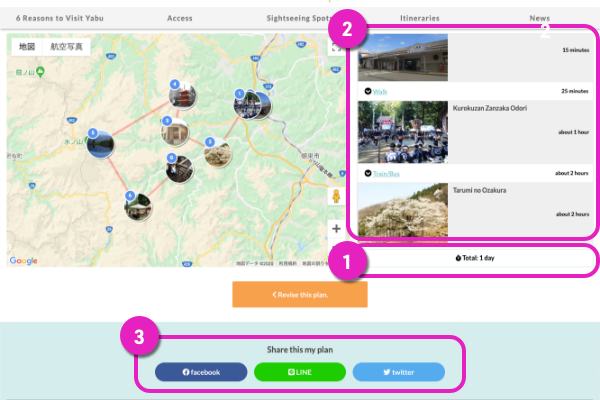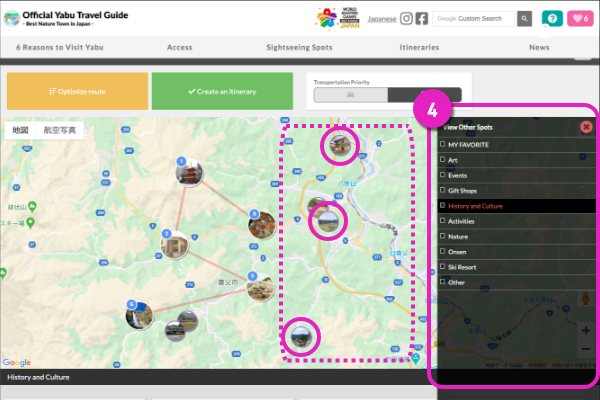How to make your own plan
Step 1
Search for places you want to visit


- Add the spots that you are interested in into ”My Plan” (your favorites)
- This can generate a route automatically by looking at the contents of ”My Plan”.
Step 2
Make a Day Plan!


- Using [My Favorite Spots] , you can put places you want to go into your plans.
- Sort in the most convenient order automatically
- Check the travel route and time by pressing the ”Direction” button (travel route by train, car or on foot will be shown).
- Create route with the ”Create an itinerary” button.
Step 3
Transfer the Plan to your smartphone and head out!

- Show the duration of the route.
- Display the entire route (by foot or by car).
- You can transfer the trip you created to your smartphone or to friends by sharing it on social media or entering your email address and sending it.
As this plan is information that was output to be shared, it will not be deleted even if the original plan is deleted.


- The plans you create will be saved under [My Plans]. Press [Create New Plan] to create a new plan.
- The plan name can be changed using the [Edit] button.
- If you press the [Pin] button, you are able to open the Category menu.
- Add the spots that you are interested in into “My Plan”


Komagata-daimyōjin

It has been said that the Mokushi (a governmental post in charge of maintaining pastures) Kiyota Family’s Third Generation, Katsusada, who had excellent horsemanship, brilliantly managed a mettlesome steed in the presence of the Shogun. That very horse was bestowed upon him and during his return to the village, the horse suddenly rampaged as he approached the northern vicinity of the now Ichikawa City. He slayed the horse and after, to pray for the repose of its soul, made a poem which is this Komagata-daimyōjin. (City designated cultural property)
| Address | 鎌ケ谷市鎌ケ谷3-3 |
|---|---|
| Tel | 047-445-1528 |
Kiyota Family Cemetary

The Kiyota family received the order of the Edo Shogunate to fulfil their role as mokushi (a governmental post in charge of maintaining pastures) of Kogane-Nakano and Shimonomaki which continued through succession and spanned over 13 generations. Mokushi managed wild horses and commanded beaters during wild horse catching and the Shogun's deer hunting. In addition to myōjitaitō (the right to bear a surname and to wear a sword), horse riding and the possession of a gun were privileges given upon them. (City designated cultural property)
| Address | 鎌ケ谷市鎌ケ谷3-3 |
|---|---|
| Tel | 047-445-1528 |
Mitsuhashi Family Cemetary

The Mitsuhashi family were the mokushi (a governmental post in charge of maintaining pastures) of Kogane-Nakano and Shimonomaki during the Edo period. This cemetery contains tombstones of over 10 generations of the family, from Gorobe II who died in Kyōhō 8 (1723) to Mitsuhashi Hisashi, who was active as a member of the House of Peers in the early Shōwa era. (City designated cultural property)
| Address | 鎌ケ谷市中沢646 |
|---|---|
| Tel | 047-445-1528 |
The Monument of Gyobun

The inscription "Hitotsuya he Hito wo fukikomu Karenokana Gyobun" is engraved. It is thought to be a haiku composed by the haiku poet Sankyū Teigyobun who followed the style of Matsuo Bashō as he passed through Kamakura-juku during his journey. As written on the monument, it was “erected by Buyosan Takahashi on Shōwa 1 (1764)”. It also served as a signpost on the Kioroshi road with “Right: Kioroshi Road” and “Left: Nakaido Road” engraved. It was built in Nakanomaki. (City designated cultural property)
| Address | 鎌ケ谷市東鎌ケ谷1-7 |
|---|---|
| Tel | 047-445-1528 |
Kamagaya Great Buddha

The Daikokuya (Fukuda) Bunuemon in Kamagaya-juku was cast by a founder in Edo-Kanda for the purpose of worshipping their ancestors. The Shaka Nyorai Buddha is made of copper with a height of 1.8 m (excluding the pedestal). It is a valuable cultural heritage which conveys the grandeur of kaigenkuyo (a Buddhist ceremony to consecrate a newly made Buddhist statue or image by inserting the eyes) and of Kamagaya-juku's heyday. It was also used as a landmark for travelers using the Kioroshikaido road. (City designated cultural property)
| Address | 鎌ケ谷市鎌ケ谷1-5 |
|---|---|
| Tel | 047-445-1528 |
National Historic Site Shimōsa Kogane Nakanomaki Site (Nomadote)

Nomadote is a general term for embankments made to effectively manage wild horses which roam freely within the maki (pasture). This includes embankments made to prevent horses from entering villages and devouring crops in the fields (nomayokedote) and direct horses to tokkome (facilities which captured wild horses) or water drinking areas (sekodote). The embankment next to the school grounds of Kamagaya Shiritsu Hatsutomi Elementary School (sekodote) is designated as a National Historic Site. Designated as a National Historic Site on February 6, Heisei 19 (2007).
| Address | 鎌ケ谷市東初富1-20(初富小学校) |
|---|---|
| Tel | 047-445-1528 |
National Historic Site Shimōsa Kogane Nakanomaki Site (Totokkome)

The site of Nakanomaki. One of the Koganemaki that the Edo Shogunate built to meet the demand for war horses. Tokkome was a facility which captured and selected wild horses. Of the three sections, one section is open to the general public. Guides are provided for the other two sections during events. Designated as a National Historic Site on Feburary 6, Heisei 19 (2007).
| Address | 鎌ケ谷市東中沢2-1 |
|---|---|
| Tel | 047-445-1528 |
Kaigarayama Park

There is a gourd-shaped pond on a vast site of about 40,500 square meters. It is perfect for a walk as you can enjoy the changes of the four seasons. In the park, there is a statue of a horse and its foal which represent the wild horses that were once in Koganemaki. The National Historic Site of Shimōsa Kogane Nakanomaki (Tokkome) is a 1-minute walk away and the Tokkome Sakura Festival is held every year on the first Saturday of April.
| Address | 鎌ケ谷市初富本町2-22 |
|---|---|
| Tel | 047-445-1528 |
Hatsutomi Inari Shrine

The Hatsutomi Inari Shrine was built on February 22, Meiji 3 (1870), receiving the bunrei (spirit) of the Fushimi Inari Shrine in Kyoto. The first chōzubachi (washbasin) of Hatsutomi Inari Shrine was made as an offering from "Kita Hatsutomi Iminchū" (roughly meaning North Hatsutomi Migrants) and is the oldest epigraph on a stone monument in Hatsutomi. It is currently on display at the local museum. In Shōwa 41 (1966) the "Hatsutomi Cultivation Centennial Monument" was erected on the shrine grounds.
| Address | 鎌ケ谷市初富本町1-5-33 |
|---|---|
| Tel | 047-445-1528 |
Tokkome Site of Uenomaki

At the Uenomaki's Tokkome (facility which captured wild horses) in Kokinmaki built in Kyōhō 7 (1722) on this site, was the management of wild horses including breeding. The site is now Kashiwa Shiritsu Daini Elementary School and a part of the tokkome's remnants can be seen from the road.
| Address | 柏市豊四季 |
|---|---|
| Tel | 04-7191-7414 |
| Fee | free |
Shintomichō Nomadote

A dual embankment built in Uenomaki. The Kashiwa City side is designated as the Minami-Kashiwa Special Green Space Conservation Area in Chiba Prefecture and is preserved in the area.
| Address | 柏市南柏1丁目 |
|---|---|
| Tel | 04-7191-7414 |
| Fee | free |
Hitachidai Nomadote

A nomadote (an embankment made to manage wild horses) built in Uenomaki. Located at the entrance of SANKYO FRONTIER Kashiwa Stadium.
| Address | 柏市あかね町 |
|---|---|
| Tel | 04-7191-7414 |
| Fee | free |
